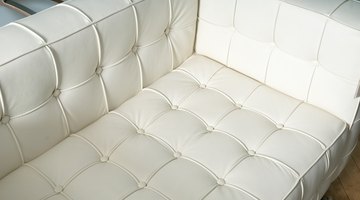How to Preserve a Vinyl Couch
Vinyl furniture is inexpensive and durable, and with proper care, a vinyl couch retains its appearance and resiliency for many years. Regular cleaning is critical. Otherwise, heavy usage, soil and body oils may cause vinyl to stiffen, crack and deteriorate.

Usually, regular household cleaning supplies are safe and effective for use on vinyl. Occasionally, products formulated especially for vinyl furniture may be beneficial.
Regular Cleaning
Soil and body oils from normal use are removed using a clean sponge or a white cloth and a mild solution of liquid dish detergent and warm water. Wipe the furniture until soil is removed. A soft-bristled brush helps if the soil is stubborn. Allowing the soapy solution to stand on the vinyl for a few seconds also helps to dislodge soil. Once the vinyl is clean, remove the detergent with a cloth or sponge dipped in clean water. Clean the vinyl couch regularly so soil and body oils don't accumulate.
Stains
To preserve a vinyl couch, stains should be removed as quickly as possible. If a solution of soap and water fails to remove stains, other stain-removal techniques may be required. If the vinyl is stained with ballpoint ink, remove it with rubbing alcohol or cover the ink stain with a cloth soaked in hydrogen peroxide for at least 30 minutes or as long as overnight. Hydrogen peroxide, mineral spirits or synthetic turpentine usually remove oil paint, crayons, tar, cosmetics or shoe polish. Mineral oil often removes stains from felt-tip markers. If chewing gum sticks to vinyls, harden it with an ice cube and chip it off, then remove residue with mineral spirits or synthetic turpentine.
Preserving Vinyl
A commercial vinyl protective finish helps protect vinyl and makes the couch more resistant to spills and stains. Vinyl care products are found at stores that sell vinyl furniture or auto supplies. Read the product label carefully and use the product according to the manufacturer's recommendations.
Warnings
Use solvents such as mineral spirits or synthetic turpentine in a well-ventilated room, away from flames, cigarettes or pilot lights. If you are unsure how a cleaning product, including mineral spirits and synthetic turpentine, may react with vinyl, test the product on a hidden area before attempting to remove stains. While nail polish remover may remove fingernail polish from vinyl, it is risky, as it may damage the vinyl. Use fingernail polish remover only if nothing else works. Avoid abrasive cleaners, which may affect the color of the vinyl.
The Drip Cap
- Vinyl furniture is inexpensive and durable, and with proper care, a vinyl couch retains its appearance and resiliency for many years.
- Usually, regular household cleaning supplies are safe and effective for use on vinyl.
- Wipe the furniture until soil is removed.
- A soft-bristled brush helps if the soil is stubborn.
- If you are unsure how a cleaning product, including mineral spirits and synthetic turpentine, may react with vinyl, test the product on a hidden area before attempting to remove stains.
- Avoid abrasive cleaners, which may affect the color of the vinyl.
References
Writer Bio
M.H. Dyer began her writing career as a staff writer at a community newspaper and is now a full-time commercial writer. She writes about a variety of topics, with a focus on sustainable, pesticide- and herbicide-free gardening. She is an Oregon State University Master Gardener and Master Naturalist and holds a Master of Fine Arts in creative nonfiction writing.
Photo Credits
- Jupiterimages/Photos.com/Getty Images
- Jupiterimages/Photos.com/Getty Images
More Articles



